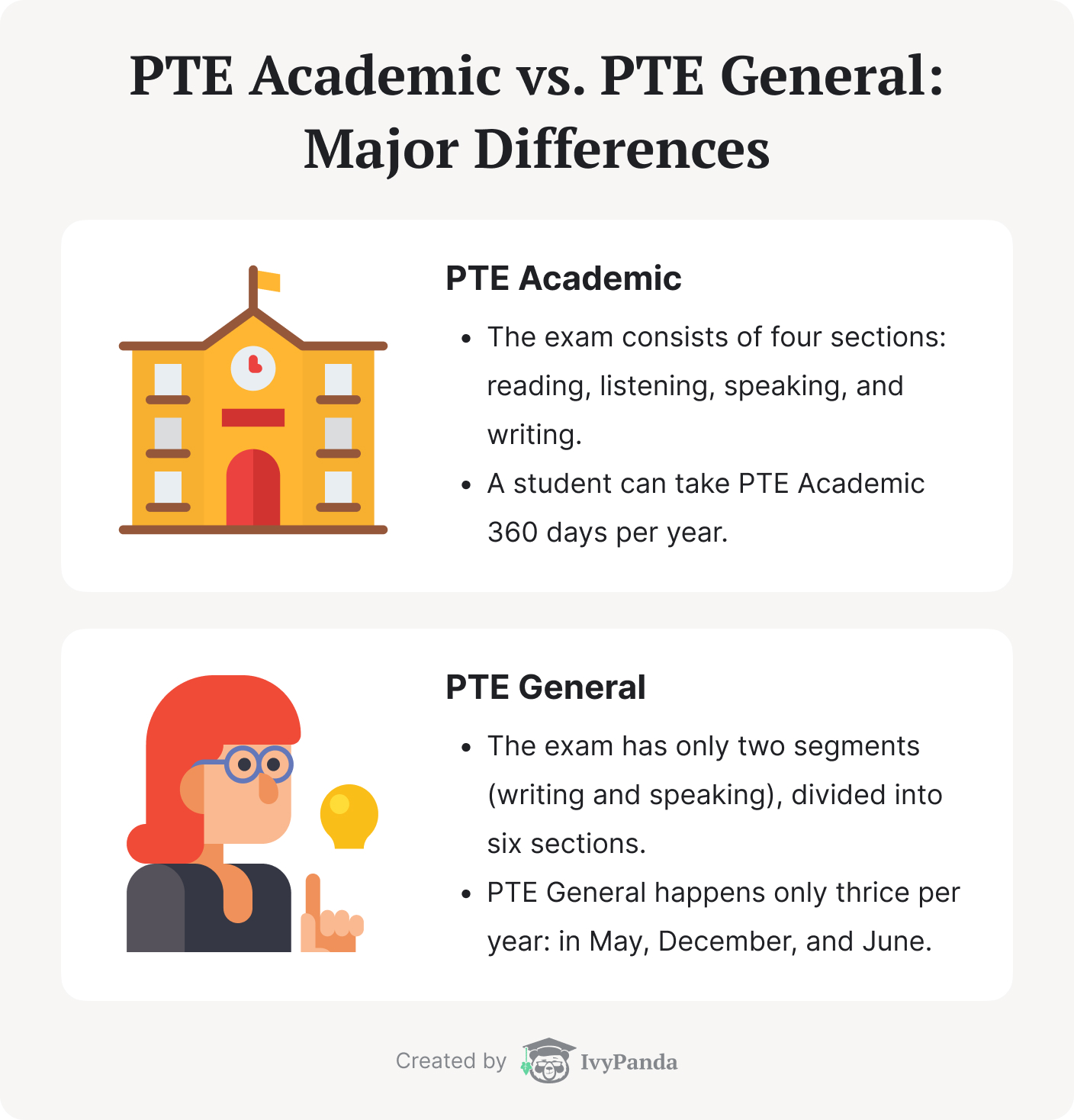Sometimes having a choice is the hardest thing on Earth. How do you make a decision, especially when it’s your future involved? Choosing between PTE vs. IELTS can be challenging. That’s why we’ve created this guide, and hopefully, it will simplify the issue for you.
In this article, you will see a thorough comparison between PTE and IELTS. So, after careful consideration, every student (or an immigration visa applicant) will be able to decide which test to take. This guide is as unbiased as possible because our team’s goal is to underline every test’s pros and cons.
👆 IELTS & PTE Definitions
Let’s start our comparison by learning some basic information about both tests. In this section, you’ll find out what these exams are and what types are available.
IELTS stands forthe International English Language Test. This test can help you work, study, and migrate to an English-speaking country. The list of these countries includes the UK, Canada, New Zealand, Australia, and the United States. The IELTS test will assess a person’s ability to speak, read, listen and write.
There are two types of test available:
- IELTS Academic
- IELTS General
PTE stands for Pearson Test of English. Just like IELTS, the PTE exam is an English test for education and immigration. It also considers four aspects of language fluency: speaking, listening, writing, and reading. This test is accepted worldwide and even by such universities as Harvard, Yale, and Princeton. The exam takes 3 hours and can be scheduled just 24 hours in advance.
There are two types of tests available depending on your reasons for taking them:
- PTE Academic:
Many foreign universities accept this test. So, if you are thinking of studying abroad, consider taking PTE Academic. It is also acceptable for immigration purposes in countries like the UK, Australia, and New Zealand. - PTE General (Home):
This test will be ideal for those who want to prove their English Level for relocation. If you’re going to work, live, and study in the UK, consider taking this test. Upon its completion, you will be granted a certificate with proof of your English proficiency.

Below, we will elaborate on the differences between the exams and the distinction between general and academic. This way, you’ll be able to decide which one to take.
👨💻 PTE vs. IELTS: General
Both tests, PTE Home and IELTS General, test your English comprehension and fluency. You might be required to pass one if you plan to immigrate to an English-speaking country. However, it would help if you considered a lot of aspects before choosing which one to pick.
This table presents a PTE vs. IELTS General comparison:
Another thing you need to know about the PTE General Test is that it is designed to reward the learning progress. There are several communication levels (from A1 to C2), which students are welcomed to test. Levels 1, 2, and 3 are used mainly for immigration purposes. Some universities accept levels 4 and 5 as proof of English level proficiency.
👩🎓 PTE vs. IELTS: Academic
Below, you will learn about the two tests required for those wishing to study abroad. Here are the essential facts about IELTS vs. PTE Academic:
PTE vs. IELTS: Speaking
In essence, the goal of a test-taker is to produce coherent and correct speech on a given topic. Yet, there are numerous differences between the speaking parts of the exams:
- Listener: As you already know, the PTE test of English is a computer-based test. Even the speaking section is done via computer. That’s why many people believe that the face-to-face interview for IELTS is much easier. After all, it is better to talk to a human than a computer, especially if you get nervous or anxious. However, it depends on the student.
- Length: In IELTS, you only get about 13 minutes to convince the examiner that your English Level is on top. In the Pearson Test of English, you get about 40 minutes to complete the section.
- Content: While for IELTS, you need to be ready to speak about daily topics, discuss with the examiner on a given case, and a personal speech. For PTE, you will be asked to make a personal introduction, read aloud, repeat sentences, describe the image, retell the lecture and answer a question.
PTE vs. IELTS: Writing
Some might say that PTE does not have a writing section because it is united with the reading part. However, students still need to compose an essay at a given period. We will discuss some of the main aspects of both exams’ writing sections in the article.
Here is how the writing section looks like in IELTS and PTE:
- Length: In the PTE exam, you will have about 40 minutes for the writing section. In IELTS, you will have a little bit more time: an hour to compose two essays.
- Content: In IELTS, first, you will have to describe a graph or a diagram. Later on, you will write an essay on a given topic. In PTE, you will need to summarize a text in one sentence. Then, you should compose an essay.
PTE vs. IELTS: Reading
The sections that test reading are usually very similar. Students’ objective is to analyze texts and answer questions about the texts. Yet, there are some differences as well:
- Length: You will have 60 minutes to finish the IELTS reading section. In PTE, you will have 30-40 minutes to complete it.
- Content: IELTS reading section will consist of three academic passages and a list of questions regarding them. As for the PTE exam, this part will have five academic passages with questions that will test various skills. You will be asked to fill the gaps, rearrange paragraphs, and answer multiple-choice questions.
PTE vs. IELTS: Listening
As you might have imagined, there are some particularities of the listening areas of both exams:
- Length: In IELTS, the listening section is around 60 minutes. In PTE, almost the same as it takes approximately 45-57 minutes.
- Content: There are four sections in IELTS Academic devoted to listening. You will receive audio files with dialogues and monologues and a list of 40 questions. In PTE, the section tests listening, writing, and reading skills. A student has to complete a variety of small tasks, from filling in the blanks to multiple-choice questions.
📊 PTE vs. IELTS: Score Comparison
In the IELTS test, your English proficiency is measured against a band score. This score ranges from 0-9. The higher yours is, the better your English proficiency is. The test creators invented this scoring system. That’s why it can be confusing when you try to relate the scores of a different test and compare them.
However, we found a solution. In the table below, see the scores you could get for PTE and IELTS.
PTE General/Home Scoring
As you already know, PTE General accesses four essential language skills: reading, listening, speaking, and writing. Five levels measure the fluency of each test taker (from level 1 to level 5).
The written component of the PTE General test has scored a maximum of 75. The spoken part can be scored up to 25 points. Each of the four sections contributes to 25% of the overall score.

PTE Academic Scoring
The overall score for PTE Academic demonstrates the performance on all test items and ranges from 10-90 points. The communicative skills that are measured are listening, reading, speaking, and writing.
The enabling skills scores demonstrate the performance in the section of writing and speaking. It shows grammar, oral fluency, spelling, pronunciation, vocabulary, and written words. Also, all scores for PTE Academic are machine scored.
IELTS Scoring
For IELTS, you will receive the overall band score and the score for each section. The final number is an average of the four areas, rounded to the nearest score.
As you know, the four sections are:
- Listening. The section consists of 40 questions, and each correct answer gives you one point.
- Reading. The section has 40 questions, and each correct answer awards one point to the test-taker as well.
- Writing. A band score is awarded for each of the four criteria:
- Completion of the tasks;
- Coherence;
- Vocabulary;
- Grammar.
- Speaking. A band score is given by the examiners based on:
- Vocabulary;
- Pronunciation;
- Grammar;
- Fluency.
⌛ PTE vs. IELTS: Which Is Easier?
By this time, you probably have an idea of what test will be more straightforward for you. However, we understand that the abundance of information can confuse anyone. That is why we’ve decided once again to demonstrate all the pros and cons of each test.
Keep reading to see the advantages and disadvantages of both tests!
PTE: Advantages & Disadvantages
Here you can learn all about the advantages and disadvantages of the PTE exam:
Overall, PTE is considered easier and faster than IELTS, yet your university of choice may not accept its results. Besides, the computer-based format of the exam can be a problem for you.
IELTS: Advantages & Disadvantages
Here we will tell you about some of the main pros and cons of the IELTS exam:
Thus, IELTS should be your primary choice for the colleges that don’t accept other test results. Yet, you should be ready to perfect your grammar and expand your vocabulary to pass. A nice way of keeping your language skills in shape would be checking out some free essay examples, as they offer a variety of topics and writing styles.
Thank you for reading till the end. We hope the article was helpful and you have decided which test to take. Share it with your peers and friends if they are facing a similar choice. Good luck with the application and the exam!
🔗 References
- What Is the IELTS Test? – Admission Test Portal, StudyPortals
- IELTS Indicator – Home of the IELTS English Test
- Compare IELTS vs Pearson’s PTE-A – IELTS.org Australia
- PTE Academic: Score Comparison vs Other Tests – Pearson Inc.
- How IELTS Is Scored – IELTS.org
- PTE SELT tests for UK visas and citizenship
- PTE Academic: The Basics – Sabrina Collier, Top Universities
- Pearson Test of English Academic (PTE Academic) – Study in the USA
- Choice Of Two Tests: IELTS Academic & General Training – IELTS IDP Education Canada

![Truths That Are Never Told about University [Infographic]](https://ivypanda.com/blog/wp-content/uploads/2021/03/happy-brunette-woman-eyeglasses-lying-grass-park-with-laptop-computer-showing-ok-sign-309x208.jpg)


Thank you very much, the article is very helpful for someone like me who had no knowledge regarding which test is easier and better to take. I do appreciate your effort, Thanks again.
Kind regards
Ed
Thanks for the feedback, Ed! Much appreciated.